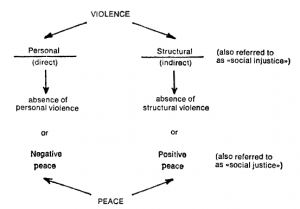A dichotomous negative and positive peace framework is perhaps the most widely used today. Negative peace refers to the absence of direct violence. Positive peace refers to the absence of indirect and structural violence, and is the concept that most peace and conflict researchers adopt. The basic distinction between positive and negative peace was popularized by prominent peace theorist Johan Galtung.

While the dichotomy is often credited to Galtung, he was not the first to describe it. Martin Luther King in the Letter from a Birmingham Jail in 1953, in which he wrote about "negative peace which is the absence of tension" and "positive peace which is the presence of justice."
These terms were likely used first by Jane Addams in her1907 book Newer Ideals of Peace. Berenice A. Carroll and Clinton F. Fink note: "Addams expressed this idea in 1899...in saying that the concept of peace had become 'no longer merely absence of war.' But in Newer Ideals of Peace, Addams used the term "negative peace" also in a different and more complex sense, to characterize certain older ideals of peace that she held to be negative or inadequate. In this sense her use of the term brought with it the implication that peace should be understood to encompass more adequate and positive goals and principles."

